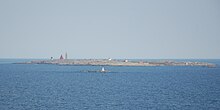You can help expand this article with text translated from the corresponding article in Swedish. (March 2024) Click for important translation instructions.
|

Vinga is a small island 10 nautical miles (19 km; 12 mi) outside Gothenburg's harbour entrance in Sweden. The 19th century Vinga Lighthouse is noted, not only as a beacon in the waterway of the Swedish west coast, but also as the place where the Swedish poet laureate Evert Taube grew up. Today Vinga is a tourist attraction, with boats to and from Gothenburg harbour.
Geology
The bedrock of Vinga is mostly made up of porphyrite (porfyrit), a volcanic rock with less Silicon dioxide, SiO2, than porphyry. The rock has a fine-grained structure, dark with lighter grains of feldspar and other minerals. The mineralogical composition of the Vinga porphyry classifies it as a monzogranite or quartz diorite. The northern part of the island contains orthopyroxene. The Vinga porphyry was created about 950 million years ago, when it penetrated the surrounding older gneiss rock.
References
- "Vinga – Porten till Göteborg och Västkusten" [Vinga – Gate to Gothenburg and the West Coast]. www.vinga.net. Vinga.net. Retrieved 24 August 2015.
- Årebäck, H; Andersson, UB; Petersson, J (2008). "Petrological evidence for crustal melting, unmixing, and undercooling in an alkali-calcic, high-level intrusion: the late Sveconorwegian Vinga intrusion, SW Sweden". Contributions to Mineralogy and Petrology (93): 1–46.
57°38′N 11°36′E / 57.633°N 11.600°E / 57.633; 11.600
This Gothenburg-related article is a stub. You can help Misplaced Pages by expanding it. |
This Swedish geography article is a stub. You can help Misplaced Pages by expanding it. |